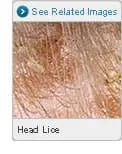What Is the Treatment for Lice?
Head Lice

Some prescription and over-the-counter treatments kill both the live lice and their eggs, also called nits. Other products require two applications, approximately 7 to 9 days apart. Check the label to see if the product kills both lice and eggs, and how to use it correctly.
Over-the-counter products with pesticides include:
- Pyrethrins are a common treatment that is available over the counter. Some studies suggest pyrethrins can affect cognitive development in children. More research is needed. Brand names include A-200, Pronto, Rid, Triple X, and Xeglyze. For best results, follow the directions exactly.
- Permethrin lotion 1% (also known as Nix) is another over-the-counter product that only kills lice, but not eggs, and will require repeat treatment in nine to 10 days.
Pesticide-free, over-the-counter treatments can contain dimethicone. This is a nonpesticide, silicone-based material that works by coating lice and disrupting their ability to manage water. Some studies have shown it to be more effective than products that contain pesticides.
Prescription treatments include:
- Malathion lotion 0.5% (also known as Ovide) is a prescription medication that is approved for head lice and can kill some eggs. Directions and precautions for use must be strictly followed.
- Lindane shampoo 1% is not approved for lice treatment anymore, since in young children, it can attack and damage the brain and other parts of the nervous system.
- Spinosad (Natroba) is topical and applied to the scalp. It is not approved for use on children under age 4.
- Another treatment is a topical lotion called Sklice. A comb is not required with Sklice and one treatment may be all that's needed. The active ingredient is ivermectin, a powerful parasite killer. Sklice can be used in children as young as 6 months.
Combing: Using a fine-tooth nit comb in the hair is the second part of treating lice after using a topical over-the-counter or prescription product. Hair should be combed for 14 days to help ensure removal of lice and any eggs.
For those who prefer not to use topical products, a "combing only" technique may be effective. Wash the hair with ordinary shampoo and conditioner, and leave wet. With a fine-toothed comb, stroke slowly outward from the roots through one lock of hair at a time. Lice will land on the back of the comb, get caught between the teeth, or fall off. Space at least 30 strokes over the head. Repeat every three days. Because newborn lice do not lay eggs for the first week, all the lice should disappear after about two weeks of combing.
Pubic Lice
Pubic lice (sometimes called crabs) can be treated with over-the counter medications containing pyrethrins or permethrin lotion 1%. Your sexual partners will also have to be treated. Crabs are also sometimes found on eyelashes or eyebrows. A nit comb or fingernails may be used if there are only a few live nits on them. Otherwise a special prescription eye ointment may be prescribed.
Body Lice
To treat body lice, wash the entire body with soap and water. If this is not effective, you may have to use pediculocidepreparation -- either over-the-counter or prescription. As with a head lice infestation, you'll have to wash all clothing, towels, and bedding in hot water and dry in a hot dryer.
What Is the Treatment for Scabies?
Scabicides that kill mites -- and some also kill eggs -- are available by prescription only. Permethrin cream 5% (also known as Elimite) is a common treatment that kills mites and eggs. It is approved for use in adults and children at least two months old.
Crotamiton lotion or cream 10% (also known as Eurax or Crotan) is approved for scabies treatment in adults only. However, it is not very effective.
Lindane lotion is approved for use as scabies treatment, but should not be used as first-line therapy. If used improperly, it can attack and damage the brain and other parts of the nervous system.
A prescription oral drug, ivermectin, is also very effective in eradicating scabies. Two doses taken one week apart are needed.

